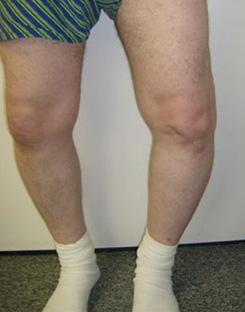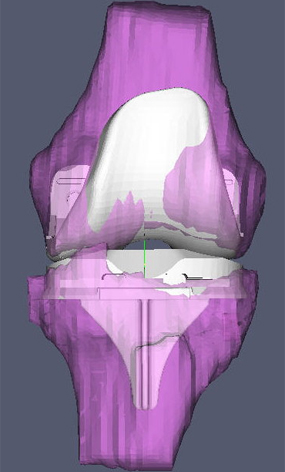 |
713-465-0696 Houston, Texas |
Custom Fit Total Knee™ Replacement If you happen to require a total replacement of the knee because more than one part of your knee is worn out, you should take advantage of NEW medical breakthrough technology as of July 2007. The breakthrough is a computer designed, Custom Fit Total Knee Replacement that restores your knee to the way it was before you got arthritis.
If you happen to require a total replacement of the knee because more than one part of your knee is worn out, you should take advantage of NEW medical breakthrough technology as of July 2007. The breakthrough is a computer designed, Custom Fit Total Knee Replacement that restores your knee to the way it was before you got arthritis.
Up until know, a small but significant percentage of total knee replacement patients have been unhappy with their surgery because the new knee “hurts”, is “too tight”, is ”too loose”, or just “doesn’t feel right”. CustomFit technology is now being shown to improve on this situation and provide a better chance for a given patient to have a perfect result. But, what is a “perfect result”? To me it is a knee that works great and feels great. This means that the knee obtains a full range of motion (bends and straightens all the way) and feels great with no pain or instability. In short, a perfect result feels like a natural, normal knee. Patients call and email all the time about which brand of implant I use or which is the best implant for them. In my opinion this is due to the direct advertising of knee implants to the public by the various manufacturers. In the United States there are five major companies that compete and several smaller ones. The major five companies are Biomet, Depuy, Smith and Nephew, Stryker, and Zimmer in alphabetical order. The truth is all of the top of the line implants of these companies are about the same. The differences between the design and materials used in these competitor's implants is minimal. The truth is that what makes the difference in how well a total knee replacement surgery turns out, is how well it is placed into the knee, not which brand of implant is used. The patient should be shopping for the best surgical implantation, and not try to pick a brand of implant for his or her case. The patient needs to understand that the motion of the knee is very complex. As the knee bends, the lower leg rotates internally. The knee is not a simple hinge joint. CustomFit technology is aimed at implanting the new knee into the correct position so that the complex motion of the human knee is retained. This is why a CustomFit knee can feel like a normal knee! The technique of implantation (How good is the surgeon and what technique of implantation does he or she use?), and the position of the knee in the patient is what counts, NOT which brand of knee is used. For your information, in some states CustomFit knees are Biomet, in other states they are Stryker. In Texas all CustomFit knees are Biomet, so I use Biomet. Up until CustomFit technology, the surgeon used standard external knee guides (click here to see them). With a standard knee replacement, the surgeon designs the implantation at surgery as he is going a long during the procedure. Many surgeons always cut the posterior cruciate ligament and then perform soft tissue balancing once the implant is cemented in the knee. Soft tissue balancing requires cutting or lengthening the collateral ligaments on the side of the knee. These additional procedures can cause more post -operative swelling and pain, and a longer recovery. In CustomFit surgery the posterior cruciate ligament is never cut. Soft tissue balancing is not necessary because the implantation is designed to be balanced from the very beginning. The breakthrough of Custom Fit Knee Replacement technology is that a computer plans the procedure so that the implant size and placement is custom fit to the patient's bones and soft tissues. Ligament releases (or cuts) are rarely, if ever, required, and the knee will obtain a more natural range of motion, both bending and straightening, automatically, as a result of the knee replacement being specifically designed for the patient's own knee anatomy. This is accomplished by obtaining an MRI of the patient's knee a week before surgery to obtain precise digital data as to the exact size dimensions of the patient's arthritic knee. The data is then sent via the internet to California-based OtisMed Corporation, and a virtual digital model of the diseased knee is made by computer. Special computer software then restores the bone shape and the alignment of the knee to what it was before any disease occurred, correcting either the bow leg or knock knee deformity that usually occurs with advanced arthritis. Next, the correct size of implant is Shape-Matched™ to the patient's corrected knee model. Single use, custom designed cutting guides are made for the individual knee (click here to see them). When the new knee is put in, the Custom Fit Knee Replacement feels like the knee felt before the arthritis occurred because the knee is now back in its natural pre-disease alignment. This is what makes this breakthrough in surgery amazing. (see illustration below)
A grateful patient of Dr. Likover, who is an engineer, prepared this animation of the process of CustomFit technology for his own knee. Please click here to see it. Dr. Likover has performed more CustomFit procedures than any physician in Texas. As of June, 2009 he has performed over 354 of them. You should take advantage of his vast experience!
For further information please go to www.CustomFitKnee.com
Click here to see actual surgical photographs of what arthritis looks like and what an installed ttotal knee looks like. DON’T CLICK IF YOU DON’T WANT TO SEE INSIDE THE HUMAN BODY. People ask me all the time what are the restrictions after a CustomFit knee. The answer is that it is made for everything but running every day. You can play tennis, golf, fish, hunt, exercise in the gym on any machine, lift weights, hike, ski, bowl and dance. If you have any further questions, please email me on the “Send a message to Dr. Likover” form on right of this page. Please read the testimonials about the CustomFit - Click Here
|
||||||||||||||||||||||||||||||||||||||||||||||||||||||||||||||||||||||||||||||||||||||||





















